When I have to choose between shutter speed and depth of field I usually lean towards faster SS’s. Sometimes it pays dividends and sometimes it doesn’t.
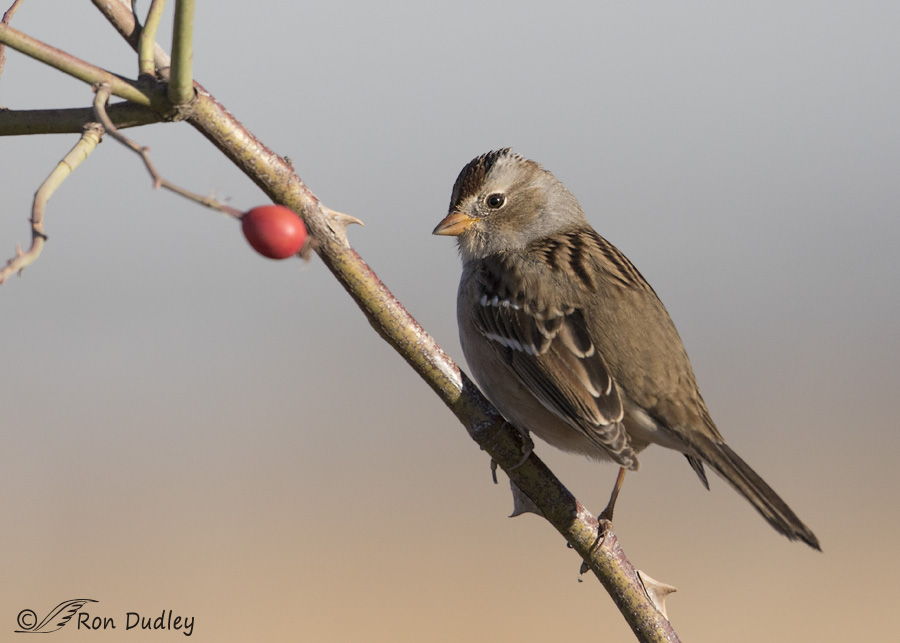
1/3200, f/6.3, ISO 640, Canon 7D Mark II, Canon EF 500mm f/4L IS II USM + EF 1.4 III Extender, not baited, set up or called in
I spent some time yesterday morning photographing White-crowned Sparrows in a wild rose bush at Farmington Bay. The bush had hundreds of bright red rose hips that presented a problem with depth of field – a sharp bird with one or more soft but still very conspicuous rose hips in the foreground is far from ideal. I’d have liked this image of a juvenile sparrow better if the rose hip were significantly sharper and it likely would have been if I’d been shooting at about f/10 (that would have made the tail sharper too).
But that would have dramatically slowed my shutter speed (I prefer to not exceed ISO 800) and these little dynamos are like greased lightning – flitty, unpredictable and incredibly fast. And my penchant for interesting action shots (take-offs, flicking wings, jumping, fighting etc) required, in my judgment, an absolute minimum shutter speed of about 1/2500 sec to have a reasonable chance at freezing the action.
So in the end (and as usual) I chose to go with relatively high shutter speeds and soft rose hips be damned.
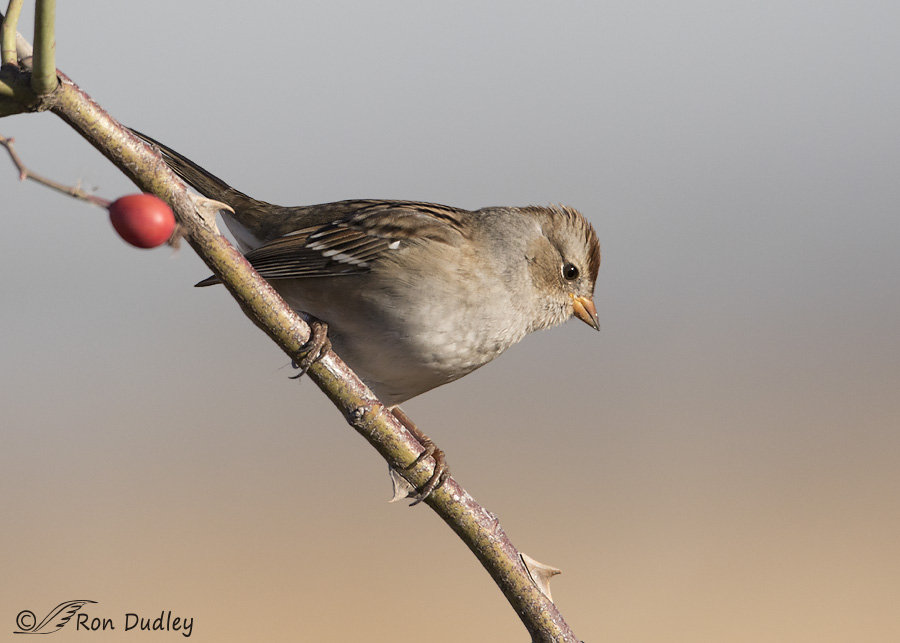
1/2500, f/6.3, ISO 640, Canon 7D Mark II, Canon EF 500mm f/4L IS II USM + EF 1.4 III Extender, not baited, set up or called in
Soon the sparrow turned on the branch and appeared to be looking for another less exposed place in the bush to land.
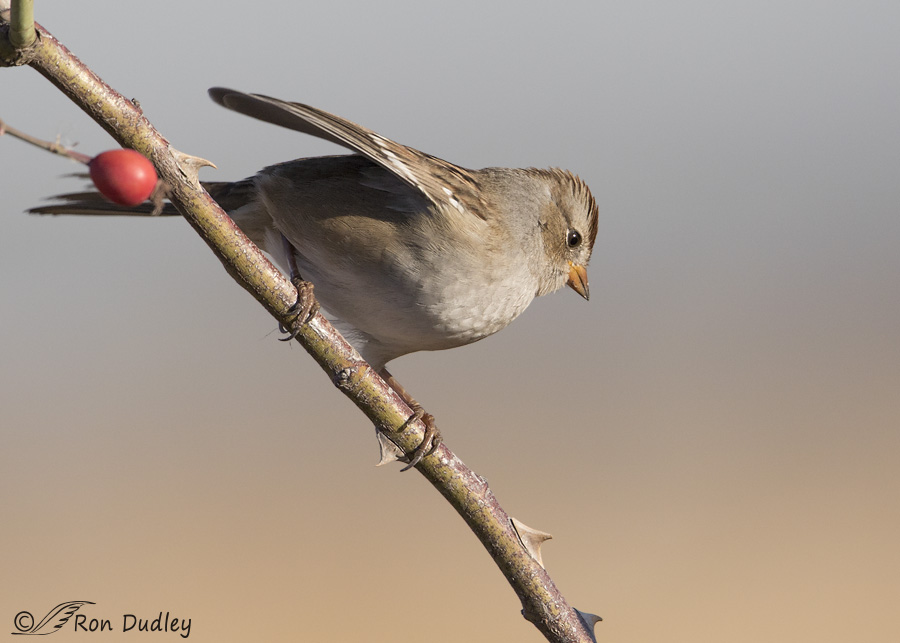 1/2500, f/6.3, ISO 640, Canon 7D Mark II, Canon EF 500mm f/4L IS II USM + EF 1.4 III Extender, not baited, set up or called in
1/2500, f/6.3, ISO 640, Canon 7D Mark II, Canon EF 500mm f/4L IS II USM + EF 1.4 III Extender, not baited, set up or called in
So I fired off a quick burst and caught the bird as it flicked its wings just prior to…
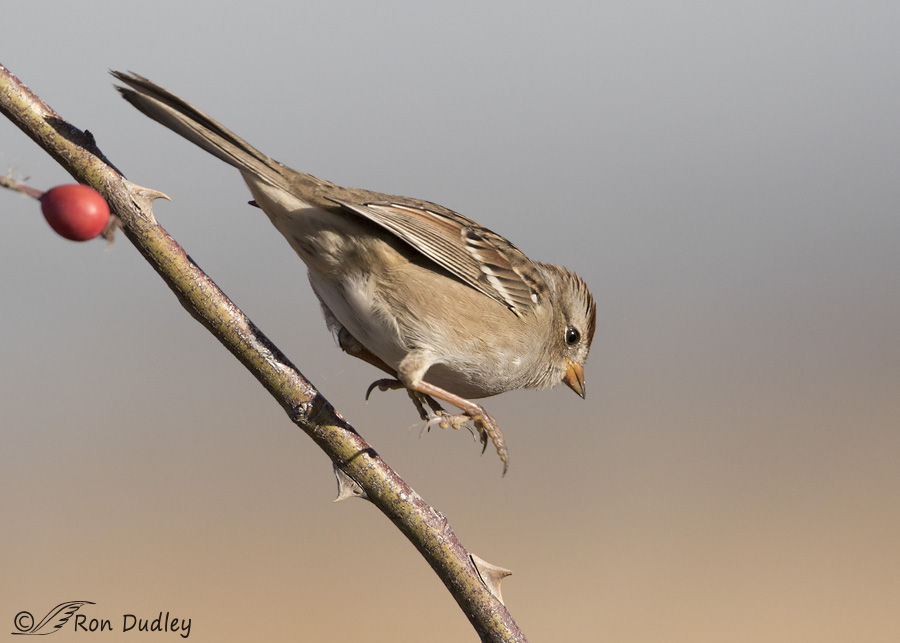
1/2500, f/6.3, ISO 640, Canon 7D Mark II, Canon EF 500mm f/4L IS II USM + EF 1.4 III Extender, not baited, set up or called in
jumping down to a safer and more protected place in the bush. It isn’t a great shot but I find it interesting so I’m still quite happy with it.
- Notice the double catch light in the eye. I suspect the smaller one up top is a reflection of the sun off my pickup.
In little birds this action is much too fast for human reflexes to respond to in time after it begins so you either have to get lucky or anticipate behavior, usually both. If I’d been at f/10 the rose hip would likely have been sharper but the sparrow would have been a blur. In this situation I’ll take a sharp bird every time.
On the other hand I don’t have any shots of this bird where the rose hip is sharp. There are lots of tradeoffs in bird photography!
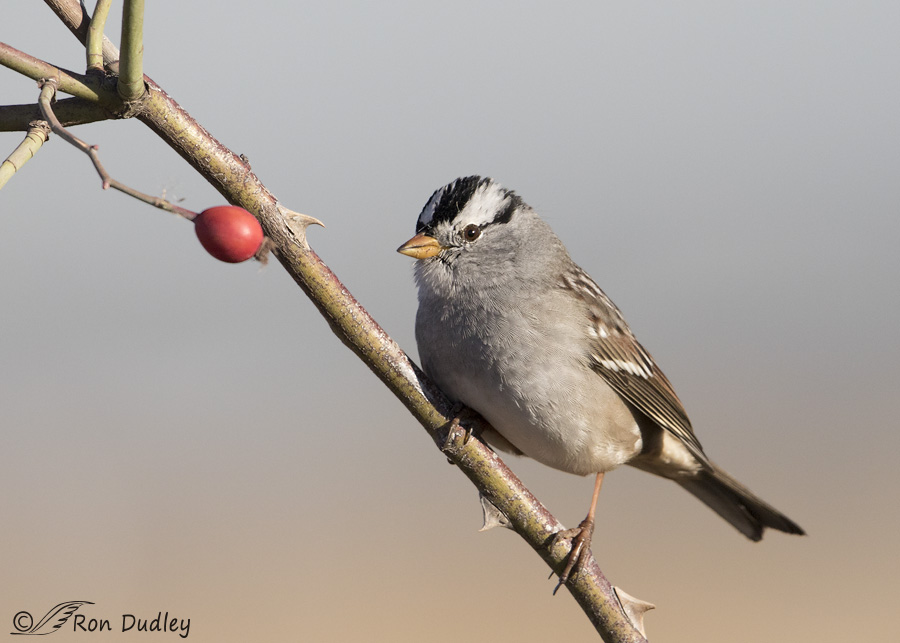
1/3200, f/6.3, ISO 800, Canon 7D Mark II, Canon EF 500mm f/4L IS II USM + EF 1.4 III Extender, not baited, set up or called in
Four minutes later another White-crowned Sparrow landed in the same spot on the branch and this time it was an adult. The rose hip is a little sharper in this shot – maybe my active focus point was on the tip of the birds bill instead of its eye which could account for that relative sharpness.
Reviewing images like these on my screen is a learning experience for me. What I’ll do next time in a similar situation is always up for grabs but knowing me I’ll once again opt for higher shutter speeds. As a result I’ll probably pay the price but then again I could get lucky…
Ron


Ron,
I like the softness of the rose hip. It demands less attention and allows your eye to explore the beautiful, sharp bird.
SUE
As Laura says – life is about tradeoffs. And we often have less control that you do with your photography. Today’s trade off is one that most of us would take I suspect.
And greased lightening is slower and more predictable than so many of the smaller birds.
Yup, those little guys are incredibly fast, EC.
You’ll get lucky! Patience, guile and determination will win!!
Thank you for this lesson, very informative. However, are you assuming a cloudless bright sunny day when you set your camera?
Or, do you decide a’ natural, when you are at the scene?
I don’t assume anything, Dick. In a situation like this I adjust my camera settings to get the minimum shutter speed I think I’ll need for the type of shot I’m most after. And then I just stick with it (mostly…)
The soft rose hip is sharp enough. I think that if I had to make a choice between which object would be sharp in a photo, I’d choose the Sparrow over the rose hip every time. To my way of thinking having the bird sharp is the better end of the trade-off. It sounds to me like your choice for the fast shutter speed is required based on what you know about the birds.
“I’d choose the Sparrow over the rose hip every time”
As would I, Susan.
All I’ve got to say is LIFE is a series of tradeoffs, complications, complexities and conundrums 🙂
Well, that’s not ALL! Oh how I love white-crowned sparrows! They’re right up there in my All-Time Top 10, so I’m delighted you chose to focus on the bird rather than the prickly rose hips that DON’T sing with a break-your-heart clarity and overall loveliness. That tells me that your instincts are right on target since you’re making those split-second decisions correctly…LOL!
Again, THANK YOU!
I’m glad you enjoyed the images, Laura. And you’re right about the lovely song of this sparrow.
I’ll be seeing these little guys soon and am really looking forward to it. The red rose hip is a perfect touch of color?..hard tp pick a favorite….
This is our time of year for migrating WC Sparrows and American Pipits, Patty. Lots of both yesterday at Farmington.
love them all especially the tail-flick and the jump. Will take any pictures you care to share. Thanks
Thank you, Gillycat.
Decisions, decisions, decision! 🙂 Great shots, Ron even if not everything is as sharp as you’d like. 🙂 I do like the one of the sparrow jumping away. 🙂
“Decisions, decisions, decision!”
Yup, and you have to make them instantly too, Judy – there’s no time to really think about it. That’s where experience and “muscle memory” become part of the equation. Even then I often make the wrong decision. To coin a phrase – “Bird photography ain’t easy!” 🙂
Yes – and I still have to “think about it”. 🙂
It sounds like a choreography involving bird behavior and associated movements, lighting, time and distance which would require much study, practice and image review to develop the muscle memory needed to pull off a good shot. Then sometimes one would need to correct in the moment before image capture to incorporate knowledge.
You keep teaching and leading down the road of more learning but I’m not certain that I want to enter that learning curve, carry the extra weight and put in the practice time to photograph birds or butterflies. I know the photos let one assess large groups for rare individuals and provide documentation.